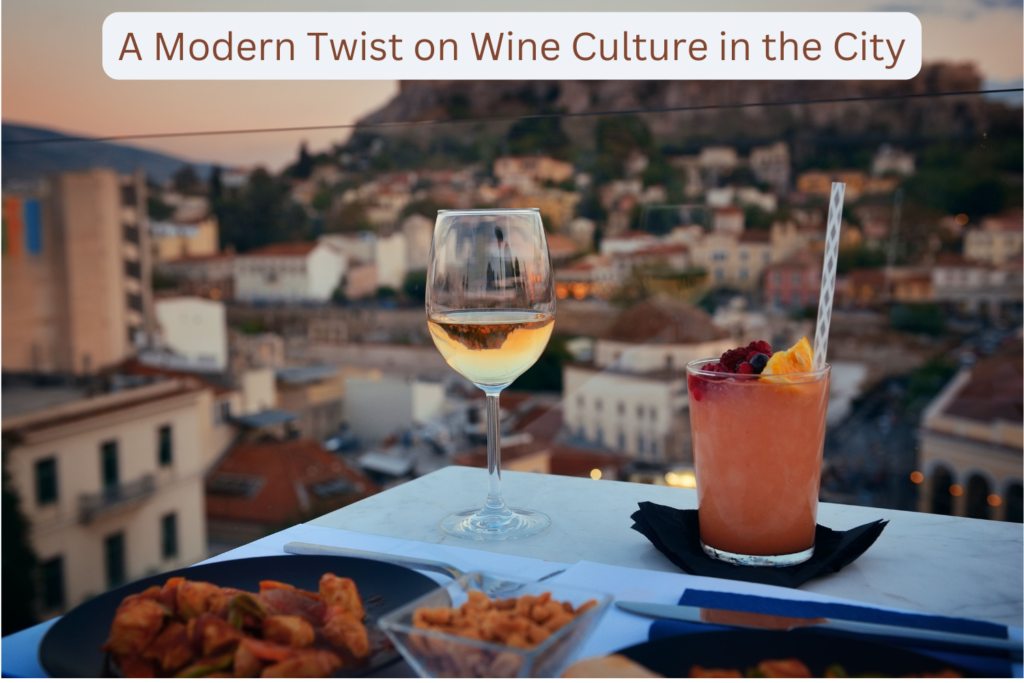Wine culture has long been associated with picturesque vineyards, sun-soaked countryside, and the tranquil allure of rural estates. However, the narrative is shifting dramatically as urban settings begin to carve out their own niche in the wine world. Welcome to the rise of the “Urban Grape”—a dynamic, contemporary twist on traditional wine culture, thriving in the bustling heart of cities. This blog post explores how the Urban Grape phenomenon is redefining the way we experience wine, blending tradition with innovation, and bringing wine culture directly into the pulse of urban life.
1. The Rise of the Urban Grape: A New Wine Revolution
The concept of the Urban Grape is more than just a trendy idea—it’s a transformative movement that’s reshaping the wine landscape. Urban wineries, wine bars, and boutique wine shops are popping up in major cities around the world, offering a fresh and accessible approach to wine that appeals to both seasoned connoisseurs and newcomers alike.
Unlike traditional wineries, urban wineries often source their grapes from distant vineyards, bringing the raw materials into city spaces where the winemaking process—from crushing to bottling—takes place on-site. This allows wine enthusiasts to experience winemaking up close, right in the heart of their city. This shift not only makes wine more accessible but also demystifies the process, breaking down barriers and inviting a broader audience to partake in the wine experience.
2. The Appeal of the Urban Grape: Why City Dwellers are Embracing Wine Culture
The appeal of Urban Grape culture lies in its accessibility, inclusivity, and innovation. Here’s why city dwellers are increasingly drawn to this modern twist on wine:
a. Accessibility and Convenience
In traditional settings, wine tasting often requires a trip to the countryside, which can be a barrier for many urbanites. Urban wineries and wine bars, however, bring the vineyard experience to the city, making it easier than ever to enjoy quality wines without leaving the urban environment. Imagine finishing a workday and heading straight to a sleek urban winery for a tasting—no long drives required.
b. A Blend of Tradition and Innovation
Urban wineries often fuse traditional winemaking techniques with innovative, city-inspired approaches. From experimenting with unconventional blends to using sustainable and eco-friendly production methods, these establishments are not afraid to push the boundaries of traditional wine culture. This blend of old and new creates a vibrant, evolving wine scene that feels fresh and relevant.
c. Social and Community-Centric
Urban Grape culture thrives on community. City-based wine spots often serve as social hubs where people gather to connect, learn, and enjoy. Many urban wineries host events such as wine tastings, workshops, and food pairings that foster a sense of community among wine lovers. This emphasis on social interaction adds a dynamic, communal element to the wine experience that is often missing in traditional settings.
d. Demystifying Wine for the Modern Consumer
One of the biggest advantages of the Urban Grape movement is its ability to demystify wine. By bringing the winemaking process closer to consumers, urban wineries educate without intimidation. Wine menus are often organized in a way that’s easy to understand, and staff are trained to guide customers in selecting wines that match their taste preferences. The goal is to make wine approachable and enjoyable for everyone, regardless of their level of knowledge.
3. Key Elements of Urban Grape Culture
To understand the Urban Grape phenomenon, it’s important to look at the key elements that define this movement:
a. Urban Wineries: Bringing the Vineyard to the City
Urban wineries are the heart of the Urban Grape culture. These wineries operate within city limits, sourcing grapes from various vineyards and producing wine on-site. Some urban wineries even offer tours, allowing visitors to see the winemaking process firsthand, from grape crushing to fermentation and bottling. This hands-on approach creates a unique and immersive experience that can’t be found in traditional winery visits.
b. Boutique Wine Shops: Curated Selections for Every Palate
Boutique wine shops play a significant role in the Urban Grape landscape. These carefully curated stores often focus on small-batch, artisanal wines that you won’t find in big-box retailers. Staffed by knowledgeable experts, these shops provide personalized recommendations and often host tasting events, making wine buying an engaging and informative experience.
c. Wine Bars with a Twist: Sip, Learn, and Socialize
Urban wine bars are redefining the traditional bar experience with their focus on education and exploration. Many offer tasting flights, allowing patrons to sample different wines side-by-side. Some even have sommeliers on hand to offer advice and insights, helping guests expand their palates in a relaxed, social setting. Food pairings, live music, and themed wine nights add an extra layer of excitement, making these spots must-visit destinations for wine lovers.
d. Sustainability in the City
Many urban wineries and wine bars are committed to sustainability, using eco-friendly packaging, reducing waste, and sourcing grapes from organic or biodynamic vineyards. This environmental focus appeals to the modern, conscious consumer who values not just quality wine but also ethical and sustainable practices.
4. The Future of Urban Grape Culture: Trends to Watch
The Urban Grape movement shows no signs of slowing down. As cities continue to embrace this modern approach to wine, several trends are emerging that are set to shape the future of urban wine culture:
a. Technology Integration: Virtual Tastings and Wine Apps
Technology is playing an increasingly important role in the Urban Grape scene. Virtual tastings and wine apps are becoming popular, allowing consumers to explore wines from the comfort of their homes. These platforms often provide educational content, reviews, and pairing suggestions, making wine exploration more accessible than ever.
b. Natural and Organic Wines on the Rise
As consumers become more health-conscious, there’s a growing demand for natural, organic, and biodynamic wines. Urban wineries are responding by offering more options in these categories, highlighting wines made with minimal intervention and sustainable practices.
c. Wine and Food Pairing Experiences
Urban wineries and wine bars are enhancing their offerings with curated food pairings, often collaborating with local chefs to create unique, seasonal menus. These pairings elevate the wine-tasting experience, showcasing how food and wine can complement each other in surprising and delightful ways.
d. Pop-Up Wine Events and Festivals
Pop-up wine events and urban wine festivals are becoming increasingly popular, bringing together wine enthusiasts in unexpected locations such as rooftops, parks, and galleries. These events celebrate the intersection of wine, art, music, and culture, creating immersive experiences that go beyond traditional tastings.
Conclusion:
The Urban Grape movement is not just about drinking wine—it’s about experiencing wine in new, exciting, and accessible ways. By bringing the vineyard to the city, urban wineries, wine bars, and boutique shops are democratizing wine culture, making it more inclusive and dynamic than ever before. Whether you’re a seasoned wine lover or a curious newcomer, the Urban Grape offers a fresh and engaging way to explore the world of wine. So, raise your glass and toast to the future of wine in the city—where tradition meets innovation and every sip tells a story.
:
FAQs:
1. What is an urban winery, and how does it differ from a traditional winery?
An urban winery is a wine production facility located within a city, unlike traditional wineries situated in rural vineyard areas. Urban wineries source their grapes from various vineyards and bring them to the city to make wine on-site. This setup allows city dwellers to experience winemaking without leaving the urban environment and often includes tasting rooms, tours, and events that connect consumers directly to the wine production process.
2. Are urban wineries sustainable?
Many urban wineries are committed to sustainability, focusing on eco-friendly practices such as using local grapes, reducing transportation emissions, and employing energy-efficient production methods. They often utilize recyclable packaging and minimal intervention winemaking techniques, appealing to consumers who value environmentally conscious products.
3. Can I visit an urban winery, and what should I expect?
Yes, most urban wineries welcome visitors and often offer tours, tastings, and events. You can expect a more casual and interactive experience compared to traditional wineries, with opportunities to learn about the winemaking process up close. Urban wineries often have knowledgeable staff or sommeliers who can guide you through tastings and help you discover new wines.
4. How does Urban Grape culture cater to beginners in wine?
Urban Grape culture is designed to be approachable and inclusive, making it perfect for beginners. Wine bars and shops often organize tastings and educational events to help newcomers understand different wine varieties and styles. Staff are usually trained to assist with recommendations based on your taste preferences, making it easy for beginners to explore without feeling overwhelmed.
5. What types of wines are typically found in urban wineries and wine bars?
Urban wineries and wine bars offer a diverse selection, including classic varietals, experimental blends, natural wines, and organic options. You’ll often find a mix of well-known and boutique labels, as well as wines that reflect the innovative spirit of the urban wine scene. This diversity allows wine lovers to explore both familiar favorites and new, unique options.

